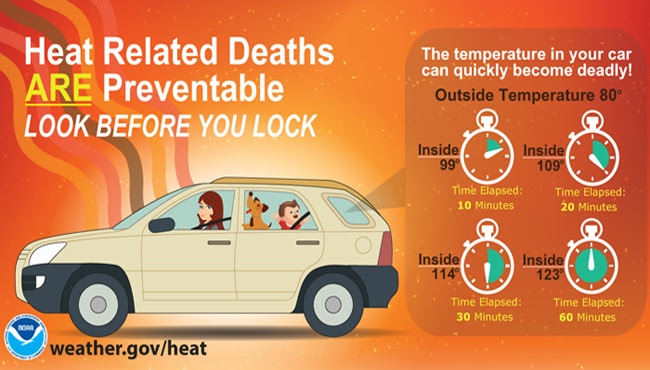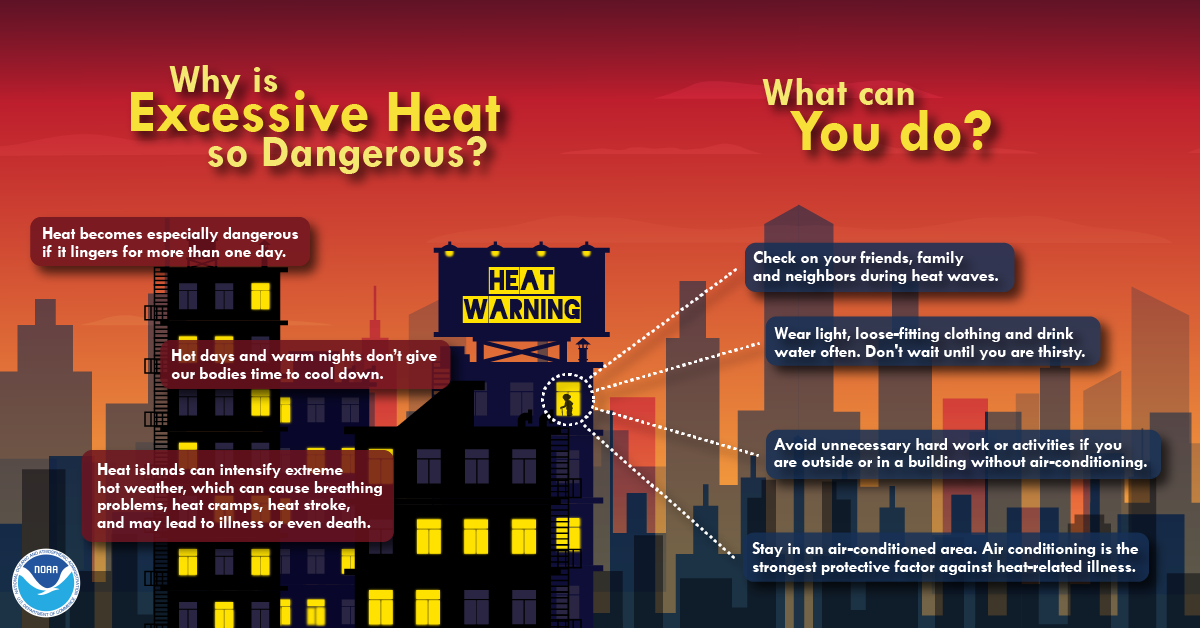Heat -- A Major Killer!
 |
 |
Heat can be a killer. The combination of hot weather and high humidity can quickly cause heat-related illness to set in. The National Weather Service issues advisories for high heat to warn you of the dangers.
An Excessive Heat Watch is issued when conditions are favorable for an excessive heat event in the next 12 to 48 hours. A watch is used when the risk of a heat wave has increased, but its occurrence and timing is still uncertain. It is intended to provide enough lead time so those who need to set their plans in motion can do so, such as established individual city excessive heat event mitigation plans.
An Excessive Heat Warning/Advisory is issued when an excessive heat event is expected in the next 36 hours. These alerts are issued when an excessive heat event is occurring, is imminent, or has a very high probability of occurrence. The warning is used for high heat conditions that pose a significant threat to life. An advisory is for less serious conditions that cause significant discomfort or inconvenience and, if caution is not taken, could lead to a threat to life.
The NWS heat alerts are based mainly on the Heat Index. The heat index takes into account heat and humidity.
Heat Index
How to read the chart: find the temperature on the left hand side, then move to the right until you find the column for the approximate relative humidity. That number will be the temperature that it will "feel" like. Example: A temperature of 95 and relative humidity of 50% will "feel" like 107 degrees.
| 0% | 5% | 10% | 15% | 20% | 25% | 30% | 35% | 40% | 45% | 50% | 55% | 60% | 65% | 70% | 75% | 80% | |
| 115 | 103 | 107 | 111 | 115 | 120 | 127 | 135 | 143 | 151 | ||||||||
| 110 | 99 | 102 | 105 | 108 | 112 | 117 | 123 | 130 | 137 | 143 | 151 | ||||||
| 105 | 95 | 97 | 100 | 102 | 105 | 109 | 113 | 118 | 123 | 129 | 135 | 142 | 149 | ||||
| 100 | 91 | 93 | 95 | 97 | 99 | 101 | 104 | 107 | 110 | 115 | 120 | 126 | 132 | 136 | 144 | ||
| 95 | 87 | 88 | 90 | 91 | 93 | 94 | 96 | 98 | 101 | 104 | 107 | 110 | 114 | 119 | 124 | 130 | 136 |
| 90 | 83 | 84 | 85 | 86 | 87 | 88 | 90 | 91 | 93 | 95 | 96 | 98 | 100 | 102 | 106 | 109 | 113 |
| 85 | 78 | 79 | 80 | 81 | 82 | 83 | 84 | 85 | 86 | 87 | 88 | 89 | 90 | 91 | 93 | 95 | 97 |
| 80 | 73 | 74 | 75 | 76 | 77 | 77 | 78 | 79 | 79 | 80 | 81 | 81 | 82 | 83 | 85 | 86 | 86 |
| 75 | 69 | 69 | 70 | 71 | 72 | 72 | 73 | 73 | 74 | 74 | 75 | 75 | 76 | 76 | 77 | 77 | 78 |
| 70 | 64 | 64 | 65 | 65 | 66 | 66 | 67 | 67 | 68 | 68 | 69 | 69 | 70 | 70 | 70 | 70 | 71 |
IMPORTANT: Heat index values were devised for shaddy, light wind conditions. Exposure to full sunshine can increase values by up to 15 degrees! Also, strong winds, particularly with very hot, dry air, can be extremely hazardous.
| Heat Index | Possible heat disorders for people in higher risk groups |
| 130 or higher | Heatstroke/sunstroke highly likely with continued exposure. |
| 105-130 | Sunstroke, heat cramps or heat exhaustion likely, and heat stroke possible with prolonged exposure and/or physical activity. |
| 90-105 | Sunstroke, heat cramps and heat exhaustion possible with prolonged exposure and/or physical activity. |
| 80-90 | Fatigue possible with prolonged exposure and/or physical activity. |
Heat Disorders
| Heat Disorder | Symptoms | First Aid |
|---|---|---|
| Sunburn | Redness and pain. In severe cases swelling of skin, blisters, fever, and headaches. | Ointments for mild cases if blisters appear and do not break. If breaking occurs, apply dry sterile dressings. Serious, extensive cases should be seen by a physician. |
| Heat Cramps | Painful spasms usually in muscles of the legs and abdomen possible. Heavy sweating. | Firm presure on the cramping muscles, or gentle massaging to relieve the spasm. Give sips of water. If nausea occurs, discontinue use. |
| Heat Exhaustion | Heavy sweating, weakness, skin cold, pale and clammy. Pulse thready. Normal temperature possible. Fainting and vomiting. | Get victim out of sun. Lay down and loosen clothing. Apply cool, wet cloths. Fan or move victim to air conditioned room. Sips of water. If nausea occurs, discontinue use. If vomiting continues, seek immediate medical attention. |
| Heat Stroke (sunstroke) | High body temperature (106 F or higher). Hot dry skin. Rapid and strong pulse. Possible unconsciousness. | Heat stroke is a severe medical emergency. Summon emergency medical assistance or get the victim to a hosiptal immediately. Delay can be fatal.
Move the victim to a cooler environment. Reduce body temperature with cold bath or sponging. Use extreme caution. Remove clothing, use fans and air conditioners. If temperature rise again, repeat process. Do not give fluids. |
Click here for more on Heat Safety!